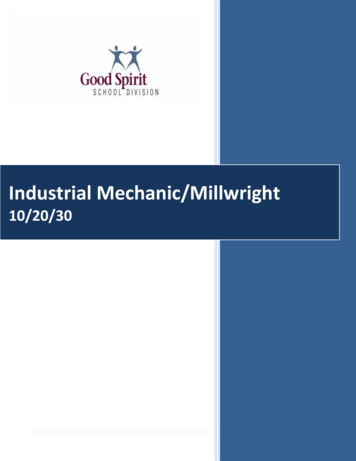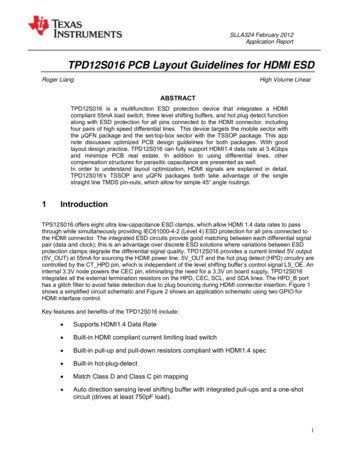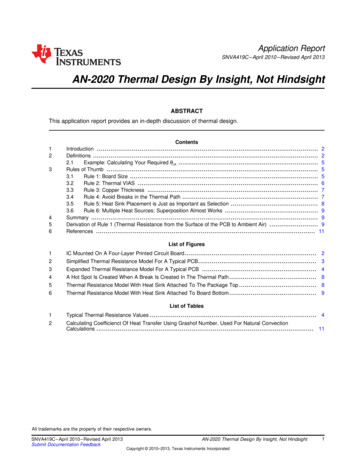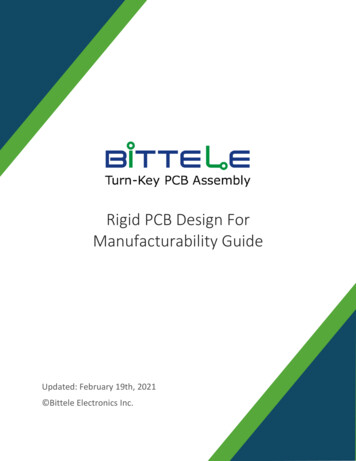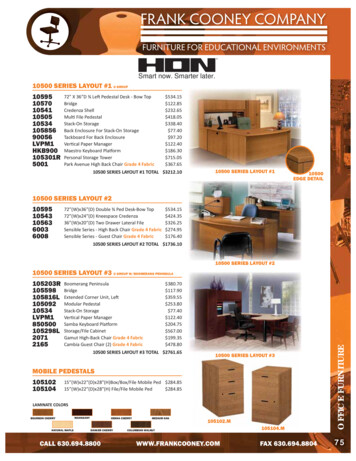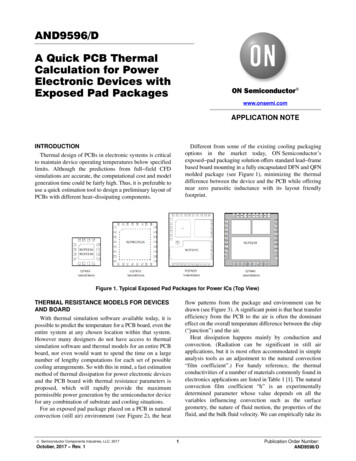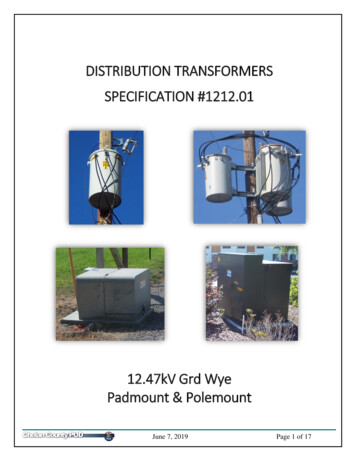
Transcription
PCB Design & Layout TipsRef: Johnson, H., High-Speed Digital Design. Prentice Hall, 1993
What is all the extra stuff? Power SupplyDecoupling capsTermination resistorsMounting holes tiedto chassis ground All designed to reduceparasitic effects
Ground Distribution Solid ground plane is best, provides continuous,low-impedance path for return current Absolutely necessary for designs with largeamounts of high speed devices (edge rates 5ns) May not be feasible due to budget constraints(Usually requires at least a 4 layer board)
Example solid ground plane layer Return current can follow any path and stay closeto the signal trace. Only breaks in plane are vias and thru holes
Ground distribution for 2 layerboards Try to dedicate onelayer as mostly solidground plane, withrouting slots cut outfor signal traces No traces on theother layer shouldperpendicularlycross a break in theground plane (largeinductive loop)www.analogzone.com : ACQ TechNote 052402.pdf
Ground distribution for 2 layerboards – right way If most of one layer cannot be dedicated to a ground plane,use a star configuration
Ground distribution for 2 layerboards – wrong way Don’t daisy chain all your ground connections together. Itforces all return currents to follow the same path, possiblycausing ground bounce.
Ground distribution for 2 layerboards, with mini ground plane If a section of the board has ICs with lots of connections and boardspace allows, draw in a mini ground plane under that section. Signals running between these ICs now have a low inductance returnpath
Example solid ground planew/analog groundAnalog sensor Moat in gnd plane, at least 25mils wide (to prevent capacitivecoupling) Prevents voltage spikes causedby digital logic from degradingthe analog noise margin No traces should cross the moat,especially high speed digitalones* Tie all gndpins in theanalog regionto analog gnd
Mixed voltage designs Your design could have as many as 5 or 6different supply voltages, which will complicatethe power distribution routing. There are two choices in where to generate thesecondary voltages– Generate all voltages centrally at the power supply anddistribute across the PCB (best when different sectionsof the board need that voltage)– Locate the generation circuit near the components thatrequire that voltage (best if one or two ICs need thatvoltage)
Mixed voltage designs –interfacing components You may have to do some level translation forsignals that communicate between two differentvoltage levels. It’s important to realize that any level translationwastes power. The customer doesn’t care that youhad to interface two parts, they only know that thebattery has to be recharged too often.
Mixed voltage designs –interfacing components To interface a 5V output to a 3.3V input on a slow signal,use a simple voltage divider. Note, however, that theseadded resistors will slow the rise time of the signal. For a faster signal, run the signal through a buffer in theVHC logic family. These parts have 5V tolerant I/O evenwhen powered by 3.3V. To interface a 3.3V output to a 5V input, run the signalthrough a buffer in the HCT product family. These partshave a TTL input stage with a Vih spec of 2V.
Decoupling capacitors Main purpose is to act as temporary charge reservoirs,guarding against voltage droop. Also serve as a path for high speed return current to jumpfrom Vcc to Gnd (remember, to an AC signal, both Vccand Gnd are AC gnd). Use 10 - 100 uF for bulk decoupling. Use 0.01 - 0.1 uF at each power pin (determined byswitching frequencies used in design). Select a voltage rating higher than Vcc. Don’t go overboard with too many caps, it will increasecost and decrease available board area.
Decoupling capacitor example Here is an example board with two 555 timers (assume that each IC isseveral inches away from the power supply) The 0.1 uF cap supplies current to the IC while its outputs areswitching until the power supply can “catch up”. The large 10 uF capacitor helps recharge all the individual 0.1 uF caps
Decoupling capacitor selection You thought the cap youjust put in your designlooked like this: It actually looks like this:
Decoupling capacitor selection Two parasitic effects must be considered when selectingdecoupling caps. As with most parasitic effects, they arehard to measure, and no two manufacturers seem to reportthem the same.– Equivalent Series Resistance (ESR) : This value will be about thesame for thru-hole or SMT packages.– Equivalent Series Inductance (ESL) : This value will be muchlower for SMT parts, compared to thru-hole. These parameters will limit the amount of instantaneouscurrent the cap can supply. Check the cap’s datasheet andmake sure that neither parameter is unacceptable for yourdesign.
Decoupling capacitor types Ceramic– Usually have the lowest ESR/ESL– Lowest cost– Are only recently available in values over 100 uF Tantalum– Available in a higher capacitance range than ceramic, inthe 220 uF – 1000 uF range– More expensive, tantalum is rare– Polarized, and have a tendency to explode– Used to be the first choice for large value decoupling,but ceramics have improved
Filtered power Some components, especially PLL’s or others with analogfunctions, may require very low ripple on the power rail. One solution is to low pass filter the power rail withdecoupling caps and ferrite beads (inductors).
Transmission Line Effects The connection from the output of one chip,across the board to the input of another chip is nota superconductor, it’s a transmission line withparasitic parameters. These effects must be considered for signals withfast rise times and/or long traces.10 ns rise time :12 in1 ns rise time :1.2 in
Transmission Line Model
Transmission Line Effects Here is the resulting simulation, note the overshoot andundershoot (rise time 5 ns).
Transmission Line SourceTermination One resistor in series can do a lot to improve the signalintegrity. The resistor should be sized so that the sourceresistance of the driver the terminating resistor characteristic impedance of the transmission line.Rs Rterm Zo There are lots of transmission line impedance calculatorson the web.
Transmission Line SourceTermination Model
Transmission Line SourceTermination The simulation shows that the overshoot and undershoothave been eliminated, due to the low pass filter.
Transmission Line ParallelTermination Source termination doesn’t work for lines that drivemultiple loads, so parallel termination at the last load isused. Ideally, Rpu Rpd would equal the characteristicimpedance of the transmission line, but most drivers can’tsource that much current.
Transmission Line ParallelTermination Model
Transmission Line ParallelTermination The overshoot and undershoot have been attenuated,whether it’s enough depends on your design.
Component placement Spend some time thinking about where to place majorcomponents, it will make routing much easier. Start with connectors, pushbuttons, etc. Their location isoften fixed due to the function or form factor of theproduct. Pay attention to which components have lots ofconnections between them, try to orient the components sothat the traces can be straightforward. Partition the board according to function, such as digital,analog and power supply. Try not to let traces from onesection stray into another section.
Component Placement Example
Critical Trace Routing Identify the most critical traces in the design:clock signals, analog signals, RF signals, etc.Route these traces first, with the most desirablelayout. Maintain at least a 3X trace width separationaround constantly switching traces like clocks(avoids crosstalk) You are smarter than the auto router software, sodon’t use it.
Safety considerations in routing Some traces have safety requirements.– AC & DC power inputs– Traces near connectors/openings in chassis Make high current traces large enough to safelyhandle the current required. Space out high voltage traces. Space out high voltage components withconductive housings.– Heat sinks– Electrolytic capacitors
PCB Specifications Minimum Line/Space Minimum6 mils Maximum Hole Size246 mils Minimum Hole Size15 mils Only plated holes allowed Only top silkscreen allowed Manufacturing files in Gerber 274X format Maximum board size for demo price: 60 sq. inches
DFD: Design-For-Debug As board space allows, add features to the PCBthat will help in debugging the design.– Unconnected headers for fixing board problems– Convenient power/gnd connections for scope probes– Test points for important subsystems (SPI bus, ADC,etc.)– Descriptive silkscreen– Extra LEDs, 7 segment display, serial port connection,speaker, etc. These extras can be no-loaded when you go toproduction.
PCB Checklist Do I have header pins for debugging? Do I have convenient VCC/GND test points? Do I have unconnected header pins for fixingboard problems? Do I have mounting holes (both in schematic andboard)? Have I printed out a paper version of the topcopper and ensured that my parts fit thefootprints? Do I have in-circuit programming for my CPU if itis surface mount? Do I have test plan for my board for when itcomes back?
PCB Design & Layout Tips Ref: Jo


